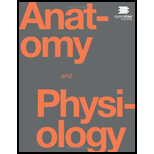
Anatomy & Physiology
1st Edition
ISBN: 9781938168130
Author: Kelly A. Young, James A. Wise, Peter DeSaix, Dean H. Kruse, Brandon Poe, Eddie Johnson, Jody E. Johnson, Oksana Korol, J. Gordon Betts, Mark Womble
Publisher: OpenStax College
expand_more
expand_more
format_list_bulleted
Textbook Question
Chapter 26, Problem 5RQ
Solute contributes to the movement of water between cells and the surrounding medium by ________.
- osmotic pressure
- hydrostatic pressure
- Brownian movement
- random motion
Expert Solution & Answer
Trending nowThis is a popular solution!

Students have asked these similar questions
Osmosis is _________________
movement of water down its concentration gradient using a protein channel
movement of materials against their concentration gradient
movement of one substance against, and one substance down their concentration gradients
movement of molecules from high concentration to low concentration using no protein channels
movement of materials down their concentration gradient using a protein channel
Covalently Attached ________ Anchor Some Proteins to Membranes
Active transport is ____________
movement of water down concentration gradient using a protein channel
movement of materials against their concentration gradient
movement of one substance against, and one substance down their concentration gradients
movement of molecules from high concentration to low concentration using no protein channels
movement of materials down their concentration gradient using a protein channel
Chapter 26 Solutions
Anatomy & Physiology
Ch. 26 - Watch this video...Ch. 26 - Watch this video...Ch. 26 - Read this article...Ch. 26 - Watch this video...Ch. 26 - Solute contributes to the movement of water...Ch. 26 - A cation has a(n) ________ charge. neutral...Ch. 26 - Interstitial fluid (IF) is ________. the fluid in...Ch. 26 - The largest amount of water comes into the body...Ch. 26 - The largest amount of water leaves the body via...Ch. 26 - Insensible water loss is water lost via ________....
Ch. 26 - How soon after drinking a large glass of water...Ch. 26 - Bone serves as a mineral reserve for which two...Ch. 26 - Electrolytes are lost mostly through ________....Ch. 26 - The major cation in extracellular fluid is...Ch. 26 - The major cation in intracellular fluid is...Ch. 26 - The major anion in extracellular fluid is...Ch. 26 - Most of the bodys calcium is found in ________....Ch. 26 - Abnormally increased blood levels of sodium are...Ch. 26 - The ion with the lowest blood level is ________....Ch. 26 - Which two ions are most affected by aldosterone?...Ch. 26 - Which of the following is the most important...Ch. 26 - Which explanation best describes why plasma...Ch. 26 - The buffer that is adjusted to control acid-base...Ch. 26 - Carbonic acid levels are controlled through the...Ch. 26 - Bicarbonate ion concentrations in the blood are...Ch. 26 - Which reaction is catalyzed by carbonic anhydrase?...Ch. 26 - Which of the following is a cause of metabolic...Ch. 26 - Which of the following is a cause of respiratory...Ch. 26 - At a pH of 7.40, the carbonic acid ratio is...Ch. 26 - Which of the following is characterized as...Ch. 26 - Plasma contains more sodium than chloride. How can...Ch. 26 - How is fluid moved from compartment to...Ch. 26 - Describe the effect of ADH on renal collecting...Ch. 26 - Why is it important for the amount of water intake...Ch. 26 - Explain how the CO2 generated by cells and exhaled...Ch. 26 - How can one have an imbalance in a substance, but...Ch. 26 - Describe the conservation of bicarbonate ions in...Ch. 26 - Describe the control of blood carbonic acid levels...Ch. 26 - Case Study: Bob is a 64-year-old male admitted to...Ch. 26 - Case Study: Kim is a 38-year-old women admitted to...
Additional Science Textbook Solutions
Find more solutions based on key concepts
While reducing the mass of a racing bike, the greatest benefit is realized from reducing the mass of the tires ...
College Physics
4. Three groups of nonvascular plants are _______, ______, and _______. Three groups of seedless vascular plant...
Biology: Life on Earth
Distinguish between microevolution, speciation, and macroevolution.
Campbell Essential Biology (6th Edition) - standalone book
A wild-type fruit fly (heterozygous for gray body color and normal wings) is mated with a black fly with vestig...
Campbell Biology (11th Edition)
8. Studies of DNA support which of the following?
a. Members of the group called australopiths were the first t...
Campbell Biology: Concepts & Connections (8th Edition)
Knowledge Booster
Learn more about
Need a deep-dive on the concept behind this application? Look no further. Learn more about this topic, biology and related others by exploring similar questions and additional content below.Similar questions
- A solution that is described by the term hypertonic means that it isarrow_forwardSimple diffusion is ____________ movement of water down concentration gradient using a protein channel movement of materials against their concentration gradient movement of one substance against, and one substance down their concentration gradients movement of molecules from high concentration to low concentration using no protein channels movement of materials down their concentration gradient using a protein channelarrow_forwardTrue or false the cell membrane equalizes osmosis pressure to protect cell.arrow_forward
arrow_back_ios
SEE MORE QUESTIONS
arrow_forward_ios
Recommended textbooks for you
 Biology Today and Tomorrow without Physiology (Mi...BiologyISBN:9781305117396Author:Cecie Starr, Christine Evers, Lisa StarrPublisher:Cengage Learning
Biology Today and Tomorrow without Physiology (Mi...BiologyISBN:9781305117396Author:Cecie Starr, Christine Evers, Lisa StarrPublisher:Cengage Learning

Biology Today and Tomorrow without Physiology (Mi...
Biology
ISBN:9781305117396
Author:Cecie Starr, Christine Evers, Lisa Starr
Publisher:Cengage Learning
Nervous System - Get to know our nervous system a bit closer, how does it works? | Neurology; Author: FreeMedEducation;https://www.youtube.com/watch?v=6O-0CVAgaEM;License: Standard youtube license